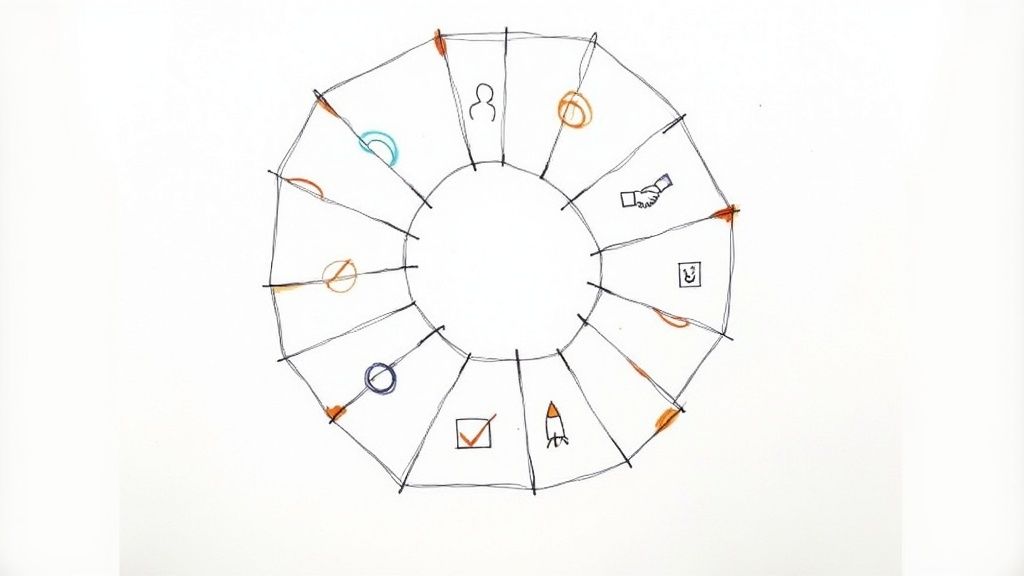Let's get one thing straight: handling a "difficult employee" is a soul-crushing distraction. Your game plan needs to be direct, documented, and focused on specific behaviors, not personality quirks. The goal is to move from vague chats to a formal improvement plan—one with crystal-clear goals and real consequences. This isn't about being a hard-ass; it's about being fair, transparent, and legally bulletproof.
The Uncomfortable Truth About Difficult Employees

Let’s be honest. You didn’t get into leadership to play workplace psychologist, but here we are. "Difficult employee" is just the polite, corporate way of describing that one person who drains your energy, tanks team morale, and makes you dread Monday mornings.
It's a huge distraction, and it's never mentioned in the company brochure.
Your gut reaction? Almost always the wrong one. Ignore it, and you send a loud message to your high performers that standards don't really matter. Go in hot with an emotional confrontation, and you’ll pour gasoline on the fire while opening yourself up to a legal mess you have no time for.
Meet the Usual Suspects
Before you can fix the problem, you have to know what you’re actually dealing with. I’ve seen them all, and they usually fit into a few familiar—and infuriating—categories. You’ve probably met them, too.
- The Brilliant Jerk: This is the toughest one. They absolutely crush their goals, but they’re arrogant, dismissive, and leave a trail of demoralized colleagues in their wake. They force you into a painful calculation: is their stellar output worth the cultural cancer?
- The Passive Aggressor: Masters of the subtle jab—the sarcastic "sure, no problem," the well-timed eye-roll, the conveniently "forgotten" email. They sidestep direct conflict but create chaos through gossip and quiet defiance, making their behavior infuriatingly hard to pin down.
- The Constant Complainer: Nothing is ever good enough. The project is doomed, the coffee is burnt, and the new software is a train wreck. Their relentless negativity is a virus that can poison the well for the entire team, turning small hurdles into massive dramas.
The true cost of a difficult employee isn't just their salary. It's the lost productivity from everyone they interact with, the great people who quit because of them, and the hours you burn managing the fallout instead of, you know, growing the business.
Why You Need a Framework, Not a Reaction
Look, it’s easy to slap a label on someone. The real work is figuring out why they're acting this way. "Difficult" behavior rarely means someone woke up and decided to be a pain in your ass. It’s almost always a symptom of something deeper. Understanding the difference is crucial for tackling workplace issues with grace and effectiveness.
Is it burnout? A fundamental skill mismatch? Or, just maybe, are they a poor culture fit you should have spotted in the interview process?
The goal isn't just to stop the behavior. It's to understand its root cause. That’s what this guide is about. We're skipping the HR fluff and giving you a practical framework to diagnose the problem, have the necessary conversations, and make a clear decision—before one bad apple spoils the whole damn bunch.
The 'What’s Really Going On' Conversation
Alright, your first instinct might be to start a meticulously detailed spreadsheet titled "Evidence Locker" and CC HR on every single email.
Pump the brakes. Before you go full courtroom drama, your first real move is a simple, direct, and private conversation. This isn't a formal warning or step one in a bureaucratic march toward termination. It’s a genuine attempt to figure out what’s actually going on.
Getting this right can solve 80% of your problems before they blow up. The key is to shift from accusation to observation. "You're always late" is a fight starter. "I've noticed you've been arriving late recently, and I'm concerned. Is everything okay?" is a conversation starter.
Setting the Stage for a Real Talk
You can't have this chat by their desk with five other people pretending not to listen. You also can't make it feel like they're being summoned to the principal's office. The environment matters.
Book a neutral space, like a small conference room. Even better? Take them for a coffee. A change of scenery can lower defenses, and your opening line sets the entire tone.
Don't start with the problem. Start with the person.
Key Takeaway: Your objective here isn't to win an argument. It's to uncover the 'why' behind the behavior. The 'why' could be a personal crisis, a professional frustration, or a simple misunderstanding. Without it, you're just guessing.
A critical part of this is having essential conflict resolution skills. Unfortunately, a lot of leaders are surprisingly bad at this. A global assessment of over 70,000 emerging leaders found that nearly half (49%) lack effective conflict management skills. The study revealed that 61% struggle to even clarify core issues before diving into a conflict—which is exactly what this conversation is designed to prevent.
The Non-Confrontational Script Framework
Forget rigid scripts. You'll sound like a robot. Instead, think in terms of a conversational flow. Here’s a simple framework I’ve used that actually works:
- The Gentle Opener: Start with something neutral. "Thanks for grabbing a few minutes. I wanted to check in and see how things are going with the new project."
- The Specific Observation: State the facts without emotion. "I've noticed in the last few team meetings that you’ve seemed disengaged, which is unlike you." Or, "I saw that the Q3 report missed its deadline on Friday."
- The Open-Ended Question: This is the most important part. Pass the mic. "I wanted to check in and see if everything is alright. What’s your perspective on how things are going?"
- Shut Up and Listen: Seriously. Stop talking. Let the silence hang if you have to. Your job now is to listen—not to rebut, not to defend, not to solve. Just listen.
Become a master of the follow-up question. When they give you a surface-level answer, gently dig deeper. "Tell me more about that." "What does that look like from your side?"
This is also a fantastic opportunity to gather feedback you might not otherwise hear. You might discover the "difficult" behavior is a direct result of a process you implemented. Ouch. But better to know. For more ideas, check out our guide on asking the right employee engagement survey questions.
This conversation is your best diagnostic tool. It’s where you separate the employee having a tough time from the one who is just a bad fit. Handle it with empathy and directness, and you’ll either solve the problem on the spot or know exactly what your next move needs to be.
From Chat to Plan: When Informal Fails
So, you had the heart-to-heart. You listened, you empathized, you thought you'd made progress. And then… nothing. Deadlines are still being ignored, team meetings are still being subtly torpedoed, and your patience is officially on its last legs.
This is the inflection point. It's where you stop being the concerned friend and start being the clear-eyed leader. The informal approach has run its course. It's time to get formal.
This isn't about punishment. It's about clarity. When hints and gentle nudges don't work, you owe it to the employee, your team, and your own sanity to make the expectations painfully, unambiguously clear.
The Dreaded PIP That Actually Works
Let's talk about the Performance Improvement Plan, or PIP. Most people hear "PIP" and immediately think it's corporate-speak for "we're building a paper trail to fire you." And honestly? They're often right.
But a good PIP is a genuine, last-ditch effort to salvage the situation—a rescue plan, not a roadmap to the exit. The difference is all in how you build it. Forget vague goals like "improve your attitude." That’s useless. You can't measure attitude.
You need to anchor the PIP in concrete, observable actions. We’re talking about SMART goals—Specific, Measurable, Achievable, Relevant, and Time-bound.
-
Instead of: "Show more initiative."
-
Try: "Propose one new process improvement idea during the weekly sync meeting every Monday for the next 60 days."
-
Instead of: "Be more responsive on Slack."
-
Try: "Acknowledge all direct messages from team members within two business hours and provide a substantive response within 24 hours."
See the difference? One is a judgment call; the other is a pass/fail test. This is one of the most important performance management best practices you can adopt because it removes emotion and replaces it with data.
This handy decision tree shows the path from an informal chat to a formal plan when things aren't improving.

The visualization makes it clear: when your initial conversation doesn't resolve the issue, the next logical step is a documented, formal plan, not another round of the same talk.
Documentation Is Your Best Friend
From this point forward, document everything. Every meeting, every missed deadline, every instance of the behavior you’re trying to correct. This isn't about creating a "gotcha" file. It’s about building an objective, factual record that protects everyone involved.
Your notes should be brutally objective.
Crucial Tip: Document behaviors, not beliefs. Don't write, "Alex was disrespectful." Write, "During the 10 AM kickoff, Alex interrupted the lead designer three times and rolled his eyes when the final budget was presented." One is an opinion; the other is a set of facts.
Proper documentation is absolutely critical. It not only provides a clear record for performance discussions but also serves as your protection if things escalate.
Documenting Employee Issues Do's and Don'ts
| Action | Do This (Objective & Factual) | Don't Do This (Subjective & Emotional) |
|---|---|---|
| Describe an Incident | "On May 10th at 2:15 PM, Jane submitted the Q2 report with three key data charts missing." | "Jane was careless again. I'm getting sick of this." |
| Quote a Statement | "During the team stand-up, Mark said, 'This new process is a waste of my time.'" | "Mark has a really bad attitude and is undermining morale." |
| Note a Missed Deadline | "The project proposal, due EOD Friday, was not received. No update was provided." | "He completely ignored the deadline. He doesn't respect my authority." |
| Record Attendance | "Arrived at 9:45 AM for the 9:00 AM mandatory client call." | "She was late again, probably overslept. It's so unprofessional." |
Sticking to the "Do" column creates a factual timeline you can rely on. The "Don't" column creates a subjective diary that can be easily challenged.
This record serves two purposes. First, it gives you specific, undeniable examples for your check-in meetings. Second, if you ultimately have to part ways, you have a clear history demonstrating that you gave them every fair chance to succeed. It closes the perception gap and keeps the process grounded in reality.
Moving to a formal process feels heavy because it is. But it’s also the most respectful thing you can do. You’re giving them a crystal-clear picture of what success looks like. No more guessing games. It’s on them to follow the map.
Protecting Your Team and Your Sanity

Here’s something they don’t tell you in management training: a difficult employee never stays in their own lane. Their behavior is like a slow leak, drip-drip-dripping negativity until the entire team culture is waterlogged.
Your best people get hit by the splash damage first. If you enjoy watching your star players quietly polishing their LinkedIn profiles, then by all means, let the toxicity fester. Because that's exactly what will happen. You’re not just managing one difficult person; you're in a fight to protect everyone else.
Managing the Collateral Damage
When you're bogged down dealing with one employee, it's easy to lose sight of the rest of the team. But make no mistake, they see everything. They see the missed deadlines you're covering, the passive-aggressive comments you’re smoothing over, and the double standards that are slowly taking root.
Your silence is deafening. Every day you fail to act, you send a clear message: this behavior is acceptable here. And that is an absolute morale killer.
Here’s how to manage the impact without turning it all into office gossip:
- Reinforce Your Values Publicly: Start making a big deal about the exact behaviors you want to see. If the problem employee is negative, publicly celebrate someone who championed a new idea. If they hoard information, loudly praise a team member for being exceptionally collaborative.
- Communicate with Intent: You can't spill the beans on private conversations, but you can address the team's health. Something as simple as, "I know there's been some friction on Project X. I want you to know I'm aware of it and I'm actively working on it," can go a long way.
- Check In with Your High Performers: Pull your key players aside. Ask them directly: "How are you really doing? What can I do to make sure you have what you need to succeed?" They will appreciate that you see them.
The cost of this distraction is staggering. Workplace disputes and personality clashes chew up about 2.8 hours per employee every single week. In the US alone, that adds up to an estimated $359 billion annual loss from tanking productivity. You can discover more about the real cost of workplace conflict to see why protecting your team is non-negotiable.
Don’t Forget to Protect Yourself
Let's be real. This stuff is exhausting. It's a massive drain on your time, energy, and emotional bandwidth. You’re the one lying awake at 3 AM replaying conversations and second-guessing every move. If you're not careful, it will burn you out completely.
You cannot pour from an empty cup. Protecting your own sanity isn't selfish—it's a core strategic responsibility.
Toot, Toot! A Personal Lesson: I once spent six months trying to "fix" a brilliant jerk. I poured endless hours into coaching and damage control. The result? He eventually left, and three of my best engineers, who had been silently suffering, almost followed him out the door. I was so focused on the problem that I nearly lost my core team.
So, what's the playbook for self-preservation?
- Set Hard Boundaries: Carve out specific time to deal with the issue, and then stop thinking about it. Don't let it bleed into your evenings or weekends. The problem will still be there on Monday.
- Find Your Founder Support Group: Vent to people who get it. Other founders or a mentor can provide that crucial outside perspective and remind you that you're not the first person to go through this.
- Trust Your Gut (and Your Documentation): You’ve done the work. You had the tough conversations and you created the plan. It’s time to stop agonizing. Trust the process and let it play out.
Your primary job is to protect the health of the entire organism, not just one struggling cell. Learning how to handle difficult employees is less about becoming a better firefighter and more about becoming a better gardener—you have to be willing to pull the weeds to let the rest of the garden thrive.
The Point of No Return: Parting Ways Professionally
You’ve done everything by the book. You had the awkward coffee chat, built a PIP that was a work of art, and documented the journey with the diligence of a court stenographer. You gave it a real shot.
Sometimes, the only move left is termination.
It’s a tough part of the job. But keeping the wrong person on the team is a slow-acting poison. This is your playbook for handling it with dignity, professionalism, and—most importantly—legal prudence.
The Final Meeting Playbook
Let's be clear: this isn't a negotiation. It's a notification. The decision is made. Your job is to deliver the news clearly, concisely, and humanely.
Who's in the room? Just you and one other person—typically from HR or another manager—to act as a witness. Never, ever do this alone.
Keep it short. 15 minutes, tops. The longer it drags on, the more room there is for arguments and emotional escalations.
Here’s the basic flow:
- Get Straight to the Point: No small talk. "Thanks for coming in. I’m here to let you know that we are ending your employment with the company, effective immediately." It feels blunt, but ambiguity is your enemy.
- State the Reason (Briefly): Connect it directly back to the PIP. "As we've discussed over the last 60 days, the performance expectations outlined in your improvement plan have not been met." Don't re-litigate the past.
- Hand Off to HR: After delivering the news, your witness can walk through the logistical details—the boring but essential stuff like final pay and benefits.
This transition is critical. It shifts the focus from the emotional decision to the procedural exit, which helps de-escalate the situation.
What Not to Say (Seriously, Don’t Say This)
What you don’t say in this meeting is even more important than what you do. Your well-intentioned attempts to soften the blow can easily backfire.
- Avoid apologies: "I'm so sorry" can be misinterpreted as an admission of guilt. Stick to empathetic but professional language like, "I know this is difficult news."
- Don't make it personal: "This is really hard for me" shifts the focus to your feelings. This moment isn't about you.
- Never offer vague platitudes: "I'm sure you'll land on your feet" comes across as condescending and is totally unhelpful.
The Bottom Line: Your script should be factual, final, and free of emotion. Deliver the news, explain the logistics, and wish them well. That’s it. The less you say, the better.
The Unsexy Logistics of a Clean Break
Once the message is delivered, the operational checklist begins. Hope you enjoy making checklists, because you’re about to become an expert.
- The Final Paycheck: Have it ready. Know your local laws regarding when final pay must be issued.
- Company Property: Have a clear plan for collecting their laptop, phone, keys, and access cards before they leave.
- Revoking Access: This should happen during the meeting, not after. Your IT team should be on standby to disable email, Slack, and all other system access.
This is also the stage where you must have your legal ducks in a row. Fumbling the termination process can turn into an expensive mess. To avoid legal challenges, get a clear understanding of wrongful dismissal and your obligations.
Consulting with an employment lawyer isn't just a good idea; it's non-negotiable. Think of it as a cheap insurance policy against a very expensive problem.
Parting ways is the toughest part of leadership. But handling it professionally ensures that both the employee and your company can finally move forward.
Got Questions? We've Got Answers
You’ve done the hard part. But even after the fire is out, a few persistent questions tend to linger.
These are the ones I get asked most often, usually over a quiet coffee when a manager is wrestling with the "what ifs." So, let’s get right into them, no sugar-coating.
What’s the Difference Between a Difficult Employee and a Toxic One?
This is the big one, and mixing them up is a costly mistake. Here's my breakdown: a difficult employee is a performance issue you can try to coach. A toxic employee is a cultural threat you have to cut out.
-
A difficult employee might consistently miss deadlines or struggle with a piece of software. Their impact is mostly contained to their own work. Think of them as a square peg in a round hole; with coaching, you can often turn things around.
-
A toxic employee, on the other hand, actively poisons the well. They gossip, undermine teammates, steal credit, and cultivate an environment of fear. The damage they cause infects the entire team.
My Two Cents: You have a bit of rope to work with when fixing "difficult." You have almost none for "toxic." Your tolerance for behavior that harms your team's psychological safety should be zero. While you coach the difficult employee, you must move decisively on the toxic one.
How Long Should a Performance Improvement Plan Last?
While there's no single magic number, the standard 30, 60, or 90 days is a solid framework. But the real answer is: the timeline has to match the problem. Trying to fix a significant skill deficit in 30 days is just setting everyone up for failure.
Here’s a practical guide I use:
-
30 Days: Perfect for clear, behavioral issues. Chronic lateness, not following a specific workflow, etc. These are habits that can be course-corrected quickly if the employee is committed.
-
60 Days: A good middle ground for performance gaps that require some learning. Maybe they need to improve their code quality or get better at client communication. This gives them enough runway to learn and show consistency.
-
90 Days: Reserve this for major skill gaps or fundamental role challenges. If someone needs to master an entirely new software suite, they’ll need the full 90 days to prove they can sustain the change.
Whatever timeline you land on, make it crystal clear from the start.
Can I Fire Someone for Just Having a Bad Attitude?
Let me be blunt: No. Don't ever do it. "Bad attitude" is dangerously vague, impossible to document objectively, and an open invitation for a legal fight.
Your job is to translate that fuzzy "bad attitude" into a list of concrete, observable behaviors.
Stop focusing on the feeling and start documenting the actions.
| Instead of This (Subjective Attitude) | Document This (Observable Behavior) |
|---|---|
| "Has a negative attitude in meetings." | "Interrupted team members three times in the Monday sync and said, 'This project is a waste of time.'" |
| "Isn't a team player." | "Refused a direct request from a colleague for help on the Q3 report, stating they were 'too busy.'" |
| "Is dismissive of feedback." | "During their performance review, they rolled their eyes and did not engage in the goal-setting discussion." |
When you zero in on tangible actions and their business impact, you shift the conversation from a personal opinion to a professional problem. It’s not about how they feel; it’s about what they do. That’s a distinction that will protect you, your team, and your company every single time.
Dealing with difficult employees is one of the most draining parts of being a leader. But getting it right—and learning when you get it wrong—is how you forge a resilient, high-performing team. To get ahead of these issues, spot potential culture misfits in the hiring stage. Async Interview helps you do just that, replacing outdated screening calls with insightful one-way video interviews. This gives you a much deeper look at candidates before you ever commit to a live conversation. Check us out at https://asyncinterview.io and see how you can hire smarter, not harder.




